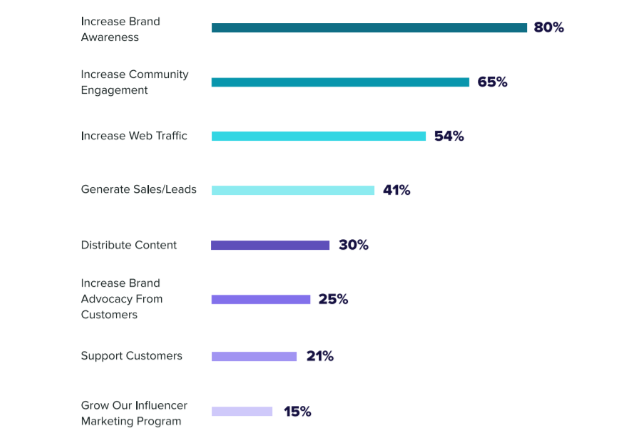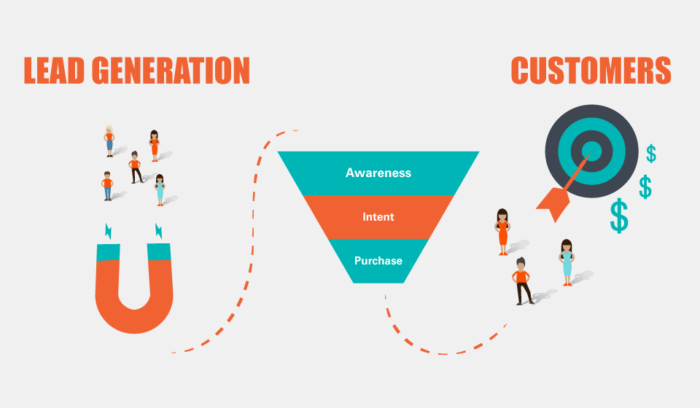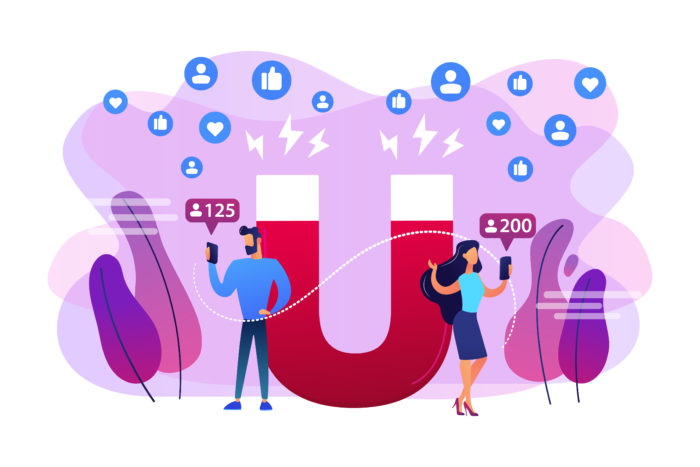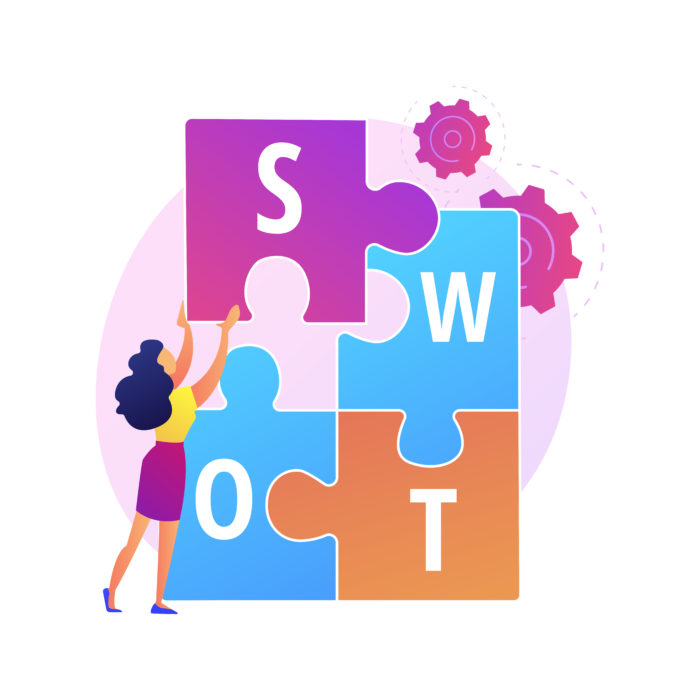So if you’ve taken the plunge, we’ll take this time to say congratulations!
Now, it is time to figure out what your next move is going to be.
Any and every business, big or small, will need to have a course of action.
How will you bring attention to the goods or services you are offering?
What way will enable you to pique the interests of those who have your attention?
Prospects may not end up convinced to make a purchase or close a deal from the get-go–this is where lead generation strategies come in.
If you are new to modern marketing and you’re not yet familiar with the events in the marketing world, don’t worry, this will be your ultimate guide to small business lead generation.
Lead Generation for Small Businesses
Lead generation strategies have been around since the beginning of time. All businesses use lead generation for a variety of different things.
Some small-business goals are the following:
-
Building strong customer relationships
-
Widening your customer reach
-
Generating revenue

(Image Source: Revechat)
In a world of constant change and advancement, especially in the technological field, saying the market has changed is an understatement. It is more than just change.
Because of the way the market has changed, the lead generation algorithm followed.
What once was a limited pool of strategies has now turned into endless possibilities.
Big corporations can operate with various channels to generate leads. In opposition, smaller businesses will find this challenging.
A small team or even a single person can operate a small business. As easy as that sounds, lead generation can be quite complicated for a small business.
But don’t worry, we’re here to help!
Keep in mind that the big guns in each industry also started where you are now.
Lead generation is an essential strategy that small businesses use to catch the attention of potential customers.

(via Business 2 Community)
Cold calling and cold emailing represent the past.
Alternative methods have taken the lead generation world by storm. Some good examples are social media platforms and web positioning.
As a small business, we will be looking for every lead generation method that we can think of.
Most B2B marketers identify lead generation as one of their biggest challenges.
Lead generation is a challenge, but we hope this guide will help you maneuver this huge aspect of modern marketing.
Leads are People Who Have Shown Interest in Your Products or Services
Many business owners and marketing teams find lead generation to be challenging. The reason behind this is the poor quality of their leads.
Quantity matters in lead generation, sure.
But how many of those leads are actually willing to convert?
Low-quality leads are those who are not engaging or interested in your product or service.
Resources can be such a waste if used by under-qualified leads.
Especially for businesses who are just starting.
You’ll want leads who will show up and close deals.
High-quality leads or Highly qualified leads are those leads ready for conversion.
You’ll want to aim for these kinds of leads because it’s easier to gauge their interest.
Highly qualified leads can be those who are already looking for solutions that your products or services may provide.
They can also be referred by your previous clients. Which again, is one of the best ways to get leads.
Especially if they were referred by those who had an amazing experience with your company’s products or services.
Leads are not only paying customers, they can also bring other leads who are ready for conversion.
Whatever the reason, leads are important for every company because of what they can give.
While big businesses can achieve your aspirations within a short time frame, making progress with a small business can seem slow at the beginning. Don’t get discouraged!
With smaller businesses, you can start with one then make your way up the lead generation ladder.
You can combine lead generation strategies for your business as long as they work well together.
Lead Generation Strategies for Small Business
When starting, small businesses may have fewer resources allocated for lead generation.
We put together a list of things you’ll want to try out before investing in paid lead generation agencies.
Some are free, and some have fees but affordable nonetheless.

(via Vectorjuice)
1Identify Your Target Market
Before anything else, you first have to identify who you’re going to be selling to.
- What am I offering for my customers?
- Who are the customers that will feel interested or helped by my products or services?
- What is the age range of those who may be interested in my products or services?
- What is my client’s budget?
These things will set the grounds for how you’ll go about your lead generation strategies.
Another helpful thing is creating a buyer persona.
A buyer persona is an ideal representation of what type of customers you would like to bring in.
Consider your present customer demographic.
- Who is buying from you?
- What makes them buy from you?
- What are they aiming for when they buy from you?
Study the patterns that these customers follow.
The more in-depth you go into customer data, the better.
Getting this data from leads will give you a better understanding of their mindset.
It will help you determine things like the kind of content to put out and where to focus your efforts.
You should have a clear picture of what type of people you’d like to bring in.
Later on, you can start researching what type of market applies to your business.
Study trends they are following, join groups and forums that may apply to your industry.
Small businesses can engage with their prospects and customers on a personal level.
Being familiar with what a certain market is after will help with the flow of engagement.
2Use SWOT Analysis

(Image Source: Vectorjuice)
Every marketer has mastered the art of SWOT.
Identify your strengths, weaknesses, opportunities and threats.
Your STRENGTHS are All the Things You’re Doing Right
They could also be things that set your business apart from others in the same niche.
Strengths can also be establishing your own brand voice or brand identity.
Give yourself some credit for all the hard work that’s gotten your business up and running.
Your WEAKNESSES are the Things You Need to Improve On
Where or what is your business lacking?
What do you need to improve?
It can be a humbling experience to step back and study your business.
You might stumble on things that need some improvements and adjustments.
When encountering challenges or obstacles along the way, learn from them, and figure out how to get through them.
Your OPPORTUNITIES are the Chances You Will Take for your Business to Succeed
Is there something that could be beneficial to your business if you invested in?
What is something that your business can gain from your campaigns or content?
What can your business take advantage of?
Your THREATS are forces that can Affect Your Marketing Strategies
The market and economy have constant fluctuations, which could affect your marketing efforts.
Competitors gaining an edge can also be a threat.
SWOT analysis digs into all the aspects of your business. You will also recognize the strengths and weaknesses of your company.
This does not only deal with the metrics of your business. It also deals with how you associate your business with customers.
Basing our SWOT analysis on our business data holds us accountable for everything we put out.
3Create Content Targeted Towards Your Audience
Now that you’ve figured out who you want to sell to, it’s time to figure out how to reel them in.
As a smaller business, you’ll want to start out with what you already have.
The brevity to put up a small business is one of them, and creativity is another.
Businesses, according to expectations, should have a plethora of things to offer their customers, but it doesn’t have to be that way.
Ask yourself, what does your business stand for?
- What is my business/team good at?
- What am I good at?
In connection to identifying your strengths and leverages, it will be easier for you to figure out the route you’ll take.
Because of the ceaseless options, you now have quite the number to choose from.
Identify your channel
Based on the demographics of your target audience, the channel will vary.
What content type or channel may appeal to a specific group of people?
Certain platforms, especially social media, are being used depending on demographics.
For example, millennials use Instagram more than any other demographic.
Plan your content.
Apart from picking the right channel to create content on, you must plan what content you put out.
Focus on what your target audience needs and wants and then go from there.
Leads are more interested in engaging with content that is meaningful or impactful.
Lately, content has come from a brand’s personal standpoint.
Blog posts and newsletters are some content channels that have been around for a while now.
They allow you to push out information about your brand that is both informative and appealing to your audience.
Yet, it is important to roll out content that doesn’t sound too much like a pitch.
Do you follow?
Some marketers might sound like they only want to make a sale instead of caring for what their customer actually needs.
Relatable content will be so much more captivating than a disengaged pitch.
Don’t throw in stuff to click-bait readers, make sure that your content is of value.
Most of your prospects are looking for some sort of answer. So make sure your stuff is compelling enough to generate sales, or at least gain your audience’s trust.
Content creation is free (in most cases) so you will need to maximize it to the best of your abilities.
It is impactful and brings in new leads, but it doesn’t cost much.
4Integrate aesthetics into substance.
Of course, we can’t forget about the visual aspect of content.
Who says that meaningful posts have to be boring?
What is the point of valuable, well thought-out content if it’s marketed in a mediocre or even uninteresting way?
If you’re serious about generating leads through your content, you need to put your best foot forward.
Anything easy on the eyes but compelling will help aid leads in the right direction.
Blog posts don’t have to be a plain text.
Adding images and graphics in connection to your content can even help you further the points you are trying to make.
With the popularity of social media platforms, we have created attractive and valuable content on a pedestal.
Platforms like Facebook and Instagram allow for businesses to showcase their creativity.
The significant thing about content is that it does not limit your creativity to any standards.
In fact, many of the strategic content that is available out there has some sort of shock-value.
Creating posts that have pleasing visuals is something that small businesses can take advantage of.
Apart from it costing little to no money, it also increases brand awareness among your prospective leads.
5Engage with your leads.
They say that establishing good relationships with your customers is the heart of any small business.
Showing customers that you’re interested in providing them with solutions rather than to focus on making a sale or closing a deal will go a long way.
Consumers these days are more inclined to brands that give them a pleasant experience.
Engaging with your customers can be as simple as answering queries in a warm, friendly tone.
Or it can also have full-on discussions with your leads.
You can also join groups and forums that apply to your content to engage with like-minded people who may get interested in your content.
Nurturing leads is the key for any business, but plays an important role for small businesses.
6Maximize social media platforms.
Let’s face it! Everyone is on social media.
And we mean everyone.
This can work out for your advantage.
The way social media is accessible makes it a great place for businesses to build their marketing strategy.
Like we mentioned earlier, creating content optimized for social media can also help you bring in leads faster.
Content put on the internet travels at break-neck speeds. This will gain some brands free promotions and advertisements.
This also makes engaging with leads easier and faster, as commenting and replying only takes a few taps.
Being easy to engage with also brings up your credibility, meaning leads will be more likely to trust you.
Put out actual content that shows prospects the real side of your business.
Behind the scenes, the people behind the work, updates.
These are only some things that are easier to put out onto your social media platforms.
The algorithm of these platforms is changing constantly.
Instagram has quite the unpredictable algorithm, Facebook allows you to target custom audiences.
Because of this, you’ll want to post regularly high-quality content and interacting with your audience.
Leads trust brands that try to connect with them and are only a message away by being on social platforms that everyone constantly uses.
Later on, you can also look into the advertising methods that these sites offer for sponsored posts.
Facebook is good at this, the way their ads sneak up on you on your news feed.
Garnering the attention of qualified leads can help a small business thrive.

(via wonder world)
7Build a website of your own.
Websites take a lot of work to build.
Not to mention how much they will cost.
You can start out with social media platforms and then build your website.
Or you can go about it oppositely.
Its price will reveal the fact that it’s worth it.
It also increases your credibility, because of the work that goes into it.
Having a website where leads can browse through your products will save both your team and your customers the hassle.
A well-designed website also gives customers the impression that they are making their own decisions.
They can spend hours on end just browsing through.
Those visitors don’t feel pressured to give you an answer right away.
But they end up converting, which is the ending result that we seek.
Search Engine Optimization For Small Business Lead Generation.
Optimizing your website for search engines (SEO) can also improve your visibility. Which helps more and more people find you when they are searching for companies that offer the same things you do.
Organic traffic to your website will only happen if you optimize your content for search engines.
There are various ways to make your content more powerful and ready for SEO.
Quality content that proves to be worthy by none other than Google will also help up the rankings on SERP.
On top of this, it also allows you to collect data from your leads through the use of forms.
8Utilize forms!
You can never go wrong with forms.
In reality, forms are for one purpose only.
Leads’ names and emails are more than enough for you to pitch your products or services.
Be creative with the forms you decide to put out.
This is an easy workaround to get people to “sign up” to free content on your website.
Be it a free trial, exclusive content, or even a newsletter.
9Build a referral network te get lead generation for your small business.
Word-of-mouth referrals are powerful among your existing customers.
You can also offer incentives for those who get you leads through referring them to your website.
Be open to collaborating with other businesses that are like yours.
Supporting those who support you create a network of supporters and connections that you can use for lead generation for your small business.
10Don’t neglect traditional methods.
With the evolution of digital marketing, we’ve all forgotten the old methods that got us here to begin with.
Depending on your demographic and product or service, traditional methods can still do wonders for your business.
Print ads, magazines, and even billboards and signs can still be effective.
11Host webinars!
The pandemic has hindered us from hosting live events that give prospects a glimpse into our worlds.
Luckily, technology has once again come through to give us the option to host events online.
Webinars are basically seminars hosted through the internet.
This is helpful if your content reaches a global market, so those living in other countries gain access.
Webinars and other live events provide many opportunities for brands and companies. For instance, it allows them to speak about their products or services while interacting with leads.
12Do more of what works for your small business lead generation.
Circling back to doing a SWOT analysis, if something is working for your business, don’t be afraid to keep doing it.
Analytics can help you gather data from your website to see what is helping you gain engagements.
Use this data to identify the things that you can still use for further campaigns.
Lessen the methods that aren’t driving much traffic to your platforms.
Lead generation companies for small businesses
Later down the road, you can even look to hire lead generation specialists or invest in companies that specialize in lead generation.
LeadFuze specializes in sales, marketing and recruiting, which are three things that can end up being what your business needs.
To sum it up…
A small business first starts with little to no leads.
But there are various ways to grow your little business.
While some small businesses have the funding and resources for lead generation, some may not.
Starting with what you have, you can create content that is 100% free to go easy on your pockets.
Tailoring the content you put out will make for a user experience that is enjoyable for them, and beneficial to you.
Start small, but do big things to go further with your company.
Want to help contribute to future articles? Have data-backed and tactical advice to share? I’d love to hear from you!
We have over 60,000 monthly readers that would love to see it! Contact us and let's discuss your ideas!
